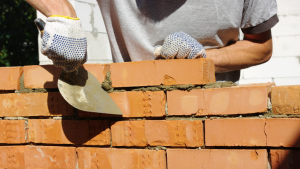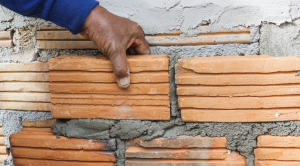Becoming a bricklayer may be your perfect career path if you have a passion for construction and enjoy working with your hands. Bricklayers play a crucial role in building structures such as houses, commercial buildings, and even bridges. In this blog post, we will guide you through the steps of how to become a bricklayer, from acquiring the necessary skills and training to finding job opportunities in the industry. So if you’re ready to lay the foundation for a rewarding career, let’s get started on your journey to becoming a skilled bricklayer.
What is a Bricklayer?

A bricklayer is a skilled tradesperson who specializes in constructing structures using bricks. They are responsible for laying and aligning bricks in a specific pattern, known as a bond, to create walls, partitions, and other structures. Bricklayers work with various types of bricks, mortar, and other materials to create sturdy and durable structures. They may also be involved in cutting and shaping bricks to fit specific dimensions or design requirements. In addition to their technical skills, bricklayers must understand building codes and safety regulations to ensure their work meets the necessary standards.
Tools and Equipment Needed for Bricklaying

When it comes to bricklaying, having the right tools and equipment is crucial for achieving professional results. Here are some of the essential tools and equipment needed for bricklaying:
- Trowel: A trowel is a handheld tool with a flat, pointed blade that is used for spreading mortar and laying bricks.
- Brick hammer: A brick hammer has a chisel-like edge that is used for cutting bricks and shaping them to fit.
- Jointer: A jointer is a tool with a curved or V-shaped end that is used to create smooth, even joints between bricks.
- Spirit level: A spirit level is used to ensure that the bricks are laid level and plumb, preventing any unevenness in the finished structure.
- Mortarboard: A mortar board is a flat surface on which you can mix and hold your mortar while working.
- Mason’s line: A mason’s line is a strong, non-stretch string tied between two points to ensure straight and even bricks.
These are just a few examples of the tools and equipment needed for bricklaying. Investing in high-quality tools is important to ensure accuracy and efficiency in your work.
How Long Does It Take to Become a Qualified Bricklayer?

Becoming a qualified bricklayer in the UK typically takes between 2 and 3 years. This timeframe allows individuals to gain the necessary skills and knowledge through a combination of on-the-job training and classroom instruction. During this period, aspiring bricklayers will learn various techniques such as mortar mixing, brick cutting, and laying bricks in different patterns. They will also develop an understanding of health and safety regulations and building codes and regulations. It is important for individuals to complete an apprenticeship or obtain a relevant qualification from a recognized institution to become a fully qualified bricklayer in the UK.
Do Bricklayers Get Paid Well?
Bricklayers in the UK can earn a competitive salary. The pay scale for bricklayers varies depending on factors such as experience, location, and the specific project they are working on. On average, bricklayers in the UK can expect to earn a respectable income that reflects their skills and expertise. With the demand for construction projects constantly growing, skilled bricklayers are in high demand, which can lead to higher earning potential. Additionally, bricklayers who have additional certifications or specialize in certain areas of bricklaying may be able to command even higher salaries. Overall, while it may vary from project to project and location to location, bricklayers in the UK generally have the opportunity to earn a well-deserved wage for their hard work and craftsmanship.
How to Become a Bricklayer?

Becoming a bricklayer requires a combination of education, training, and hands-on experience. Here are the steps to help you become a bricklayer:
- Obtain a high school diploma or equivalent: While a high school diploma is not always required, it can be beneficial to have a basic education in math and reading.
- Complete an apprenticeship program: Many bricklayers start their careers through apprenticeship programs, which provide on-the-job training and classroom instruction. These programs typically last 3-4 years and cover topics such as blueprint reading, masonry techniques, and safety procedures.
- Gain practical experience: During your apprenticeship or after completing your training program, it is important to gain practical experience by working under the supervision of experienced bricklayers. This will allow you to develop your skills further and learn different techniques.
- Obtain certification (optional): While not always required, obtaining certification from a recognized organization can demonstrate your competence and professionalism as a bricklayer. The Brick Industry Association offers certifications assessing your masonry construction knowledge and skills.
- Continuously improve your skills: As with any trade, it is important to stay updated with the latest techniques and advancements in the field of bricklaying. Attend workshops, take additional courses, and seek out opportunities for professional development to continuously improve your skills as a bricklayer.
Following these steps, you can embark on a rewarding career as a skilled bricklayer.
Career Advancement Opportunities in Bricklaying

Bricklaying offers a range of career advancement opportunities for those looking to grow and excel in the field. One common path is to become a bricklaying supervisor or foreman, overseeing teams of bricklayers and coordinating projects. This role requires strong leadership skills and technical expertise in bricklaying.
Another option is to specialize in a specific area of bricklaying, such as restoration work or architectural detailing. By developing niche skills, bricklayers can position themselves as experts in their field and command higher salaries.
Some bricklayers also start their own businesses, becoming self-employed contractors or entrepreneurs. This allows them to have more control over their work and potentially earn higher profits. With the demand for skilled bricklayers expected to increase in the coming years, there are plenty of opportunities for career growth and advancement in this field.
Tips for Success as a Bricklayer

Becoming a successful bricklayer requires a combination of technical skills, physical strength, and attention to detail. Here are some tips to help you excel in your career as a bricklayer:
- Develop your skills: Take the time to learn and master the fundamental techniques of bricklaying. This includes understanding different bond patterns, mortar consistency, and proper joint finishing.
- Stay physically fit: Bricklaying is a physically demanding job that requires strength and endurance. Regular exercise, proper lifting techniques, and maintaining good overall health can help you stay fit for the job.
- Pay attention to detail: Precision is key in bricklaying. Take the time to measure and align each brick accurately, ensuring straight lines and consistent mortar joints. Attention to detail will result in a more professional finish.
- Continuously learn and improve: Stay updated on new techniques, tools, and materials in the industry. Attend workshops or training sessions to enhance your skills and expand your knowledge.
- Communicate effectively: Effective communication with clients, contractors, and colleagues is crucial for success as a bricklayer. Clear communication helps ensure that everyone is on the same page regarding project requirements, deadlines, and expectations.
- Prioritize safety: Always prioritize safety on the job site. Use personal protective equipment (PPE), follow safety guidelines, and be aware of potential hazards.
By following these tips, you can set yourself up for success as a bricklayer and build a rewarding career in the construction industry.
Safety Measures When Working as a Bricklayer

When working as a bricklayer, it is important to prioritize safety to prevent accidents and injuries. Here are some safety measures to keep in mind while on the job:
- Wear appropriate personal protective equipment (PPE), such as hard hats, safety goggles, gloves, and steel-toed boots, to protect yourself from falling objects and potential hazards.
- Use proper lifting techniques to avoid strains or back injuries when handling heavy materials. Having a team or equipment in place for lifting heavy objects is also important.
- Keep your work area clean and organized to reduce the risk of tripping or slipping. Make sure tools and materials are properly stored when not in use.
- Be aware of your surroundings and communicate with your fellow workers to avoid accidents caused by miscommunication or lack of awareness.
- Follow proper procedures when operating equipment, such as scaffolding or power tools, and ensure they are well-maintained and inspected regularly.
By following these safety measures, you can create a safer work environment for yourself and your colleagues while working as a bricklayer.
Benefits of Being a Bricklayer

Being a bricklayer has many benefits, making it an attractive career choice. One of the main benefits is the job security and stability that comes with being in a trade. As long as there is construction happening, there will be a need for skilled bricklayers.
Additionally, bricklaying offers opportunities for career advancement and specialization. With experience and further training, bricklayers can become experts in specific areas, such as restoration or architectural brickwork, which can lead to higher-paying jobs.
Another benefit is the sense of satisfaction that comes from seeing tangible results of your work. From building homes to creating beautiful structures, bricklayers have the opportunity to leave a lasting impact on the built environment.
Finally, being a bricklayer also offers the potential for earning a competitive salary, especially as you gain experience and expertise in the field. Overall, being a bricklayer provides stability, opportunities for growth, and the chance to work on meaningful projects.
Conclusion
Becoming a bricklayer is an exciting career path that offers stability and opportunities for growth. By following the steps outlined in this guide, you can start your journey toward becoming a skilled bricklayer. From gaining the necessary skills and knowledge to finding apprenticeship opportunities, this blog has provided you with valuable insights into the bricklaying profession. So, if you have a passion for construction and enjoy working with your hands, don’t hesitate to pursue a career as a bricklayer. You can build a successful future in this rewarding field with dedication and hard work.









